Abstract
Purpose
To estimate the current cancer burden in Korea, newly diagnosed cancer cases and cancer incidence rates were calculated for the years 2003~2005.
Materials and Methods
The cancer incidence cases and rates were calculated from the Korea National Cancer Incidence Database. Crude and age-standardized incidence rates were calculated by gender for specified cancer sites in 5-year age groups.
Results
From 2003 to 2005, 398,824 cases of cancer were newly diagnosed in Korea (218,856 in men and 179,968 in women). For all sites combined, the crude incidence rate (CR) was 300.0 and 248.2 for men and women and the age-standardized incidence rate (ASR) was 297.0 and 191.2 per 100,000, respectively. Among men, five leading cancers were stomach (CR 66.0, ASR 64.2), lung (CR 48.5, ASR 50.3), liver (CR 44.9, ASR 42.1), colon and rectum (CR 37.9, ASR 37.2), and prostate cancer (CR 12.7, ASR 13.8). Among women, five leading cancers were breast (CR 37.3, ASR 29.0), thyroid (CR 36.2, ASR 28.8), stomach (CR 34.1, ASR 25.4), colon and rectum (CR 28.0, ASR 21.1), and lung cancer (CR 17.9, ASR 12.8). In the 0~14-year-old group, leukemia was the most common in both sexes; in the 15~34 group, the most common cancer was stomach cancer for men and thyroid cancer for women; in the 35~64 group, stomach cancer for men and breast cancer for women; among those 65 and over, lung cancer for men and stomach cancer, for women, respectively.
Conclusion
The cancer incidence rates have increased in recent years, and more cancers are expected to develop as Korea is quickly becoming an aged society. The cancer incidence statistics in this report can be used as an important source to effectively plan and evaluate the cancer control program in Korea.
Cancer is the leading cause of death in Korea. To estimate the cancer burden, a cancer registry is an essential component for planning and monitoring any national cancer control program (1). Since the Korea National Cancer Incidence Database (KNCIDB) for the year 1999 was first constructed in 2003, the Korea Central Cancer Registry (KCCR) has reported the annual cancer incidence rates in collaboration with eight regional population-based cancer registries, site-specific cancer registries, and the National Health Insurance Corporation (NHIC) (2,3).
This report presents the national cancer incidence rates for 2003~2005 based on the KNCIDB.
The KCCR developed a standardized form to identify cancer cases using hospital discharge records. All malignant neoplasms and in situ cases are classified according to the International Classification of Diseases for Oncology, 3rd edition (4) and converted according to the International Classification of Diseases, 10th edition (5). To improve the completeness of the nationwide cancer registry data, several sources of data were combined: national death certification data from the Korea National Statistical Office (KNSO), medical claims data from the NHIC, and additional medical record reviews. The KNCIDB is described in detail elsewhere (2,3). The list of KCCR-registered cases and a list of cancer cases from claims made through the NHIC for each region were sent to the regional cancer registries to find missing cases. The data collection methods at the regional cancer registries were both passive and active. From 2002 to 2008, we conducted an ad hoc nationwide medical record review survey of patients who were newly diagnosed during 1999~2006, and who were not registered in either registration system (hospital-based cancer registration and regional population-based cancer registration).
The KNCIDB was further refined by confirming multiple primary cancers according to the rules of the International Agency for Research on Cancer (6). Other duplicated cases were removed with the help of experts from a variety of fields, such as clinicians, pathologists, and medical records administrators.
All cancer cases newly diagnosed during 2003~2005 were included in this study. Approximately 84.4% (336,470 of 398,824 cases) were registered through the KCCR program, while 15.6% of the cases were collected through the population-based regional cancer registries, site-specific cancer registries, and other ad hoc medical records review surveys.
The crude incidence rate (CR) per 100,000 by gender was calculated for 18 age groups (i.e., 0~4 years, 5~9 years, and groups of 5-year categories up to 85 years and over) and standardized to the WHO world standard population (7).
The population used as the denominator to calculate cancer incidence rates was the midyear population (the population on July 1) in a given year, which was estimated by taking the average of available population data from the KNSO on December 31 for 2 consecutive years (8). Detailed population was listed in appendix 1.
We calculated several indices to measure the quality of the Korean cancer registry data: the mortality/incidence (M/I) ratio and the percentages of microscopic verification (MV%), death certificate only (DCO%), primary site unknown (PSU%), and age unknown (Age UNK%) (9). For the M/I ratio, an indicator of data completeness, the mortality data on cancer by gender, age group, and site for the same period as the registered cases from the KNSO were compared to the incidence data from the registry, which are presented as percentages. The MV%, an indicator of the validity of the diagnostic information, is the percentage of cases for which the diagnosis was based on morphological verification of a tissue specimen. The DCO%, the percentage of cases registered based on death certificates only, is an index of diagnostic validity. PSU% and Age UNK% are the percentages of cases registered with unknown primary sites or unknown age, respectively. The cumulative risk for developing cancer during a specified time period was computed as the proportion of initially susceptible individuals in a population who become incident cases during a given time period, in the absence of other competing causes of death. Cumulative risk was derived from the cumulative rate, which is the sum of each age-specific rate over each year of age from birth to a defined upper age limit. In this report, we used 74 years old as the upper age limit.
Between 2003 and 2005, 398,824 cancer cases were newly diagnosed in Korea (218,856 in men and 179,968 in women). For all sites of cancer, the CRs were 300.0 and 248.2, and the age-standardized incidence rates (ASRs) were 297.0 and 191.2 per 100,000 for men and women, respectively. The overall cumulative risk for developing a cancer before the age of 74 was 30.0% for males and 18.7% for females (Table 1). In males, the five leading primary cancer sites were the stomach (CR 66.0, ASR 64.2), lung (CR 48.5, ASR 50.3), liver (CR 44.9, ASR 42.1), colon and rectum (CR 37.9, ASR 37.2), and prostate (CR 12.7, ASR 13.8). In females, the most common primary cancer sites were the breast (CR 37.3, ASR 29.0), followed by the thyroid (CR 36.2, ASR 28.8), stomach (CR 34.1, ASR 25.4), colon and rectum (CR 28.0, ASR 21.1), and lung (CR 17.9, ASR 12.8).
In the 0~14-year age group, leukemia was the most common cancer in both genders. For males, stomach cancer was the common in the 15~64-year age group, while lung cancer was more frequent in the over 65-year age group. For females, the most common forms of cancer for each age group were as follows: 15~34 years, thyroid cancer; 35~64 years, breast cancer; and stomach cancer for age 65 years and older (Tables 2, 3). Fig. 1 and 2 plot the age-specific incidence of the five and seven major cancers in men and women, respectively. In men, the incidence of the five major cancers increased gradually with age, while in women, the incidence of breast and thyroid cancers increased with age until the late 40 s and early 50 s and then subsequently decreased.
In terms of the quality indices, the KNCIDB showed acceptable values for the cancer incidence data for 2003~2005 (Table 4). In particular, the MV% of the diagnosis was 76.8% for men and 83.6% for women. The DCO% was 4.7% for men and 4.3% for women. The M/I ratio was 56.3% and 39.4% for men and women, respectively. The PSU% was 1.4% and 1.5% for the respective sexes. The Age UNK% was 0% for both men and women.
This report presents the nationwide cancer incidence statistics for Korea during 2003~2005. Compared to cancer statistics for 1999~2002 reported in the Cancer Incidence in Five Continents, Volume IX (10), the crude cancer incidence rates during 2003~2005 increased by 21.6% (17.9% in men and 26.5% in women). While these increases might have resulted from improved completeness and the aging population in Korea during recent years, these increases in cancer incidence could be real, as the age-standardized incidence rates have also increased. A possible explanation for these increases is the change to a Westernized lifestyle, such as the high consumption of fat and less physical activity, together with early detection.
In Korean men, stomach, lung, liver, colorectal, and prostate cancers are the five most common cancers, accounting for two-thirds of the cancer burden. In Korean women, breast, thyroid, stomach, colorectal, and lung cancer account for two-thirds of the cancer burden. In particular, increases in colorectal, thyroid, prostate, and female breast cancer have been observed. The rapid increase in thyroid cancer incidence in women might be attributable to improved diagnostic techniques, leading to the detection of disease that would have gone undetected previously, rather than a true increase in the incidence of thyroid cancer, as in the United States (11).
Assessing the quality of the data for completeness and validity is essential. In particular, completeness is a critically important component (12). Various methods have been proposed to measure the completeness of registration. Using the Ajiki method (13), the completeness of incidence for 2003~2005 in Korea is 94.6%. We also evaluated the completeness and validity of the incidence data for 2003~2005 using the indices MV%, DCO%, M/I ratio, PSU%, and Age UNK%. All of the values for these indices satisfied the evaluation criteria published in the Cancer Incidence in Five Continents, Volume IX (14). Here, DCO% was 4.7% for men and 4.3% for women (improved from 6.1% for men and 5.8% for women during 1999~2002). The PSU% of the KNCIDB (1.4% for men and 1.5% for women) is relatively low compared to those of most countries (14). For Age UNK%, which rarely exceeds 1% in developed countries, only one case with an unknown age occurred in our data.
Cancer certainly has become a very important public health concern in Korea, and as Korea becomes an aged society, the cancer burden will continue to increase. The cancer incidence rates in this report can be used as an important source to plan and evaluate the cancer control program in Korea more effectively.
Appendix
Appendix 1
Total population* of Korea during 2003~2005 and the world standard population
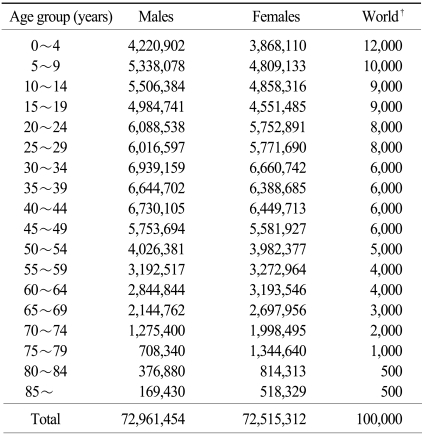
*for a given year, the midyear population size was estimated using the average of the population on december 31 for 2 consecutive years. total population was the sum of midyear population during a given period, †the world standard population is a theoretical proportion of the world population used for standardization.
Acknowledgement
The authors owed a debt of gratitude to the Korea Central Cancer Registry (KCCR)-affiliated Hospitals, non KCCR-affiliated Hospitals, and the National Health Insurance Corporation, and the National Statistical Office for data collection.
References
1. World Health Organization. National Cancer Control Programmes. Policies and Managerial Guidelines. 2002. 2nd ed. Geneva: World Health Organization.
2. Shin HR, Won YJ, Jung KW, Kong HJ, Yim SH, Lee JK, et al. Nationwide cancer incidence in Korea, 1999~2001: first result using the National Cancer Incidence Database. Cancer Res Treat. 2005; 37:325–331.

3. Shin HR, Jung KW, Won YJ, Yim SH, Sung JH, Seo SW, et al. National Cancer Incidence for the Year 2002 in Korea. Cancer Res Treat. 2007; 39:139–149. PMID: 19746208.

4. Fritz A, Percy C, Jack A, Shanmugaratnam K, Sobin L, Parkin DM, et al. International Classification of Disease for Oncology. 2000. 3rd ed. Geneva: World Health Organization.
5. Manual of the International Statistical Classification of Diseases, Injuries, and Causes of Death, 10th revision. 1992. Geneva: World Health Organization.
6. Working Group Report. International Rules for Multiple Primary Cancers (ICD-O, 3rd ed.). Eur J Cancer Prev. 2005; 14:307–308. PMID: 16030420.
7. Segi M. Cancer Mortality for Selected Sites in 24 Countries (1950~1957). 1960. Sendai: Tohoku University School of Medicine.
8. Korean Statistical Information System. Korea National Statistical Office. Available at URL:
http://kosis.nso.go.kr.
9. Skeet RG. Jensen OM, Parkin DM, MacLennan R, Muir CS, Skeet RG, editors. Quality and quality control. Cancer Registration Principles and Methods. 1991. Lyon: IARC;p. 101–107.
10. Shin HR, Won YJ, Jung KW, Park JG, Hong EK, Suh CI, et al. Curado MP, Edwards B, Shin HR, Storm H, Ferlay J, Heanue M, editors. Cancer incidence in Korea (1999~2002). Cancer Incidence in Five Continents. 2007. Vol. IX. Lyon: IARC.
11. Davies L, Welch HG. Increasing incidence of thyroid cancer in the United States, 1973~2002. JAMA. 2006; 295(18):2164–2167. PMID: 16684987.

12. Parkin DM, Bray F. Evaluation of data quality in the cancer registry: principles and methods. Part II. Completeness. Eur J Cancer. 2009; 45:755–764.

13. Ajiki W, Tsukuma H, Oshima A. Index for evaluating completeness of registration in population-based cancer registries and estimation of registration rate at the Osaka Cancer Registry between 1966 and 1992 using this index. Nippon Koshu Eisei Zasshi. 1998; 45:1011–1017. PMID: 9893469.
14. North AB, South CD. Curado MP, Edwards B, Shin HR, Storm H, Ferlay J, Heanue M, editors. Cancer incidence in Antartica (1998~2002). Cancer Incidence in Five Continents. 2007. Vol. IX. Lyon: IARC;IARC Scientific Publications IV. 160.
Table 1
Total number of cancer cases and age-standardized cancer incidence rates by gender in Korea during 2003~2005
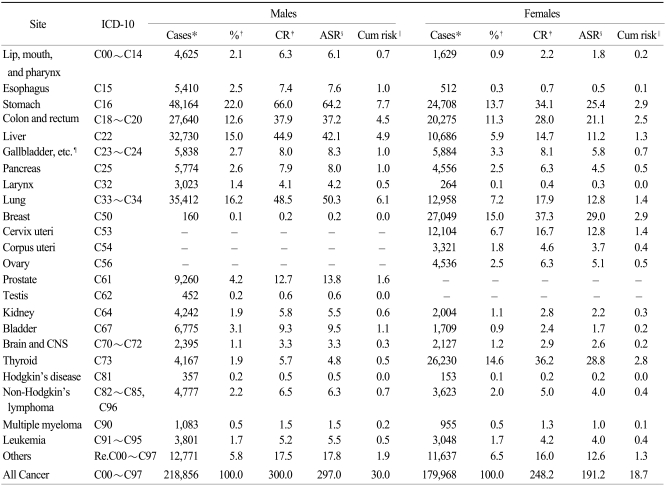




 PDF
PDF Citation
Citation Print
Print



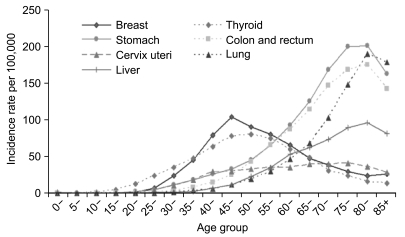
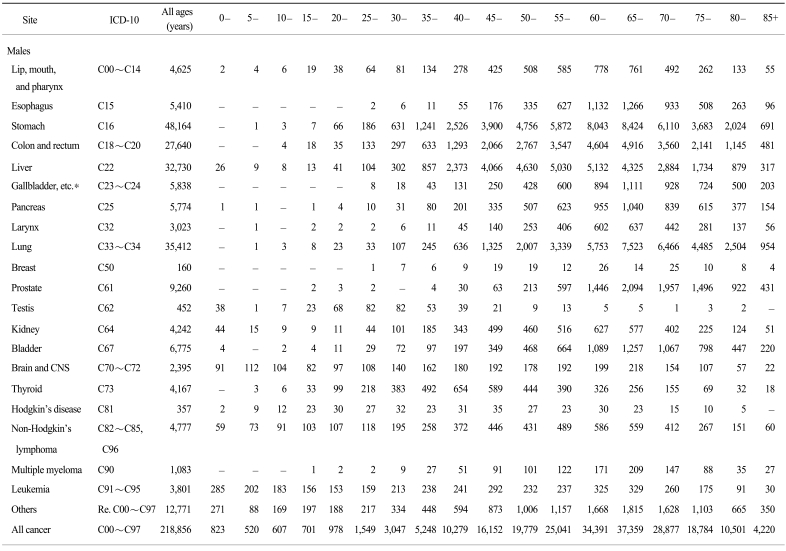
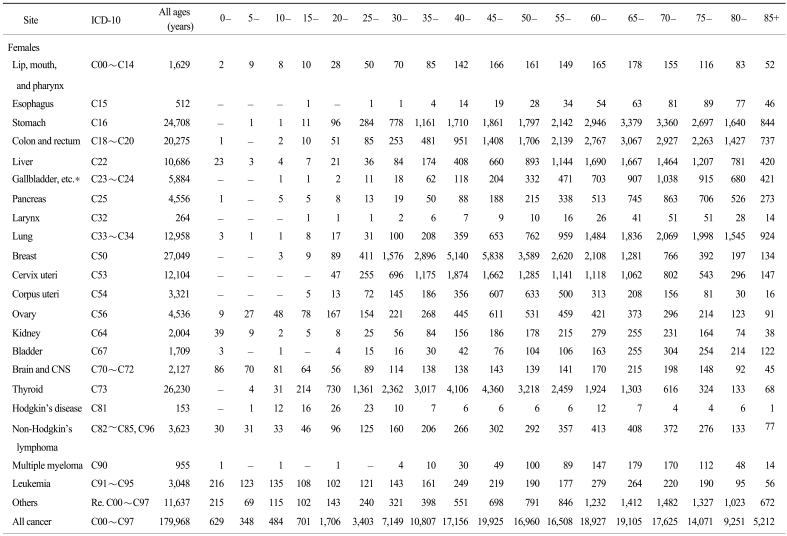
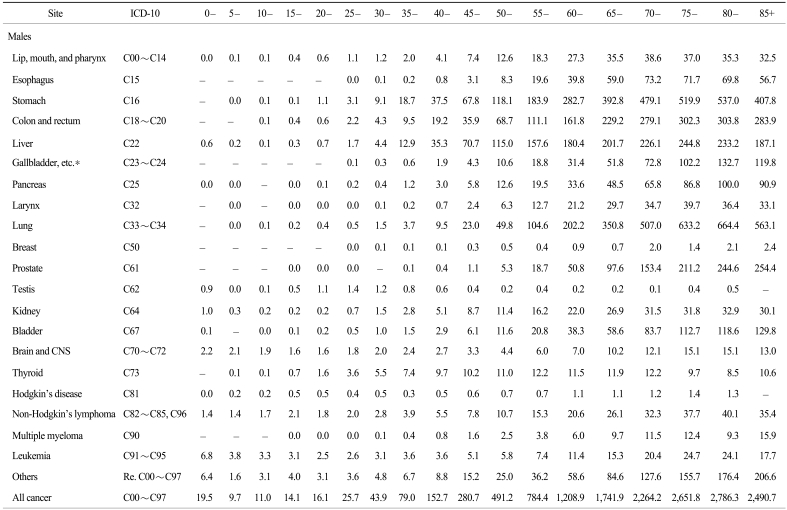
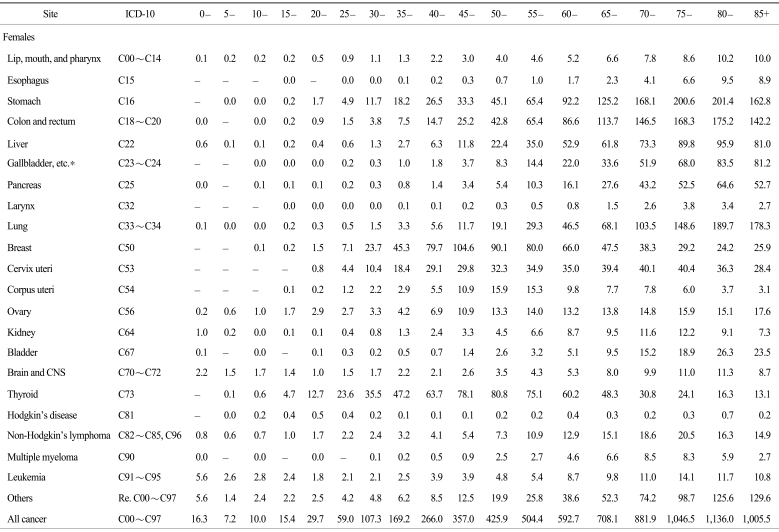
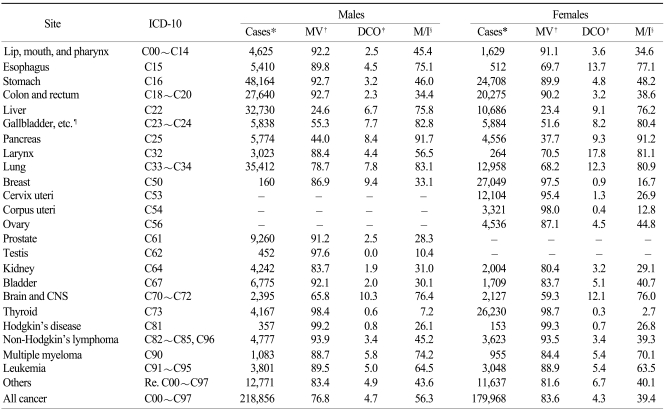
 XML Download
XML Download